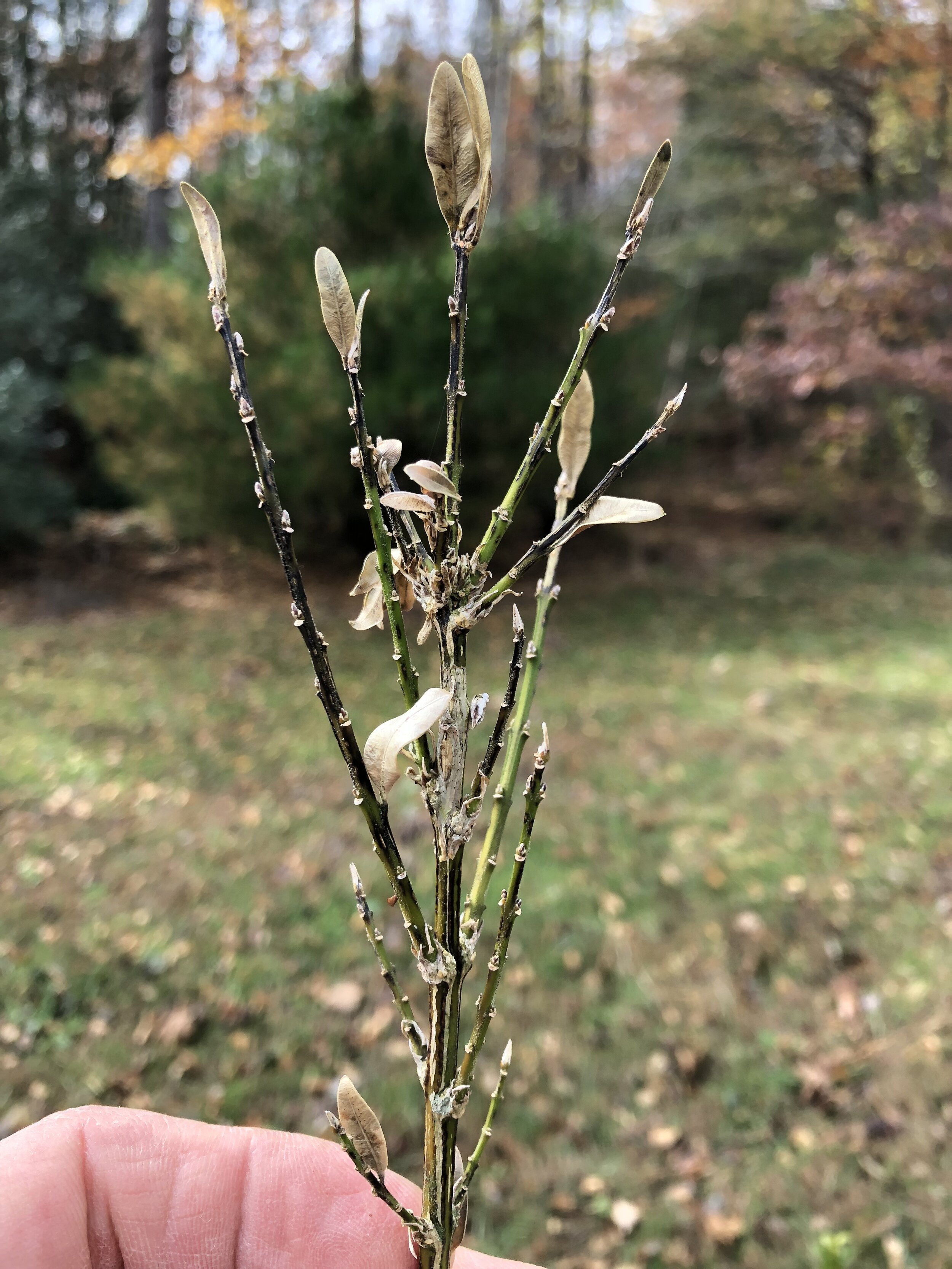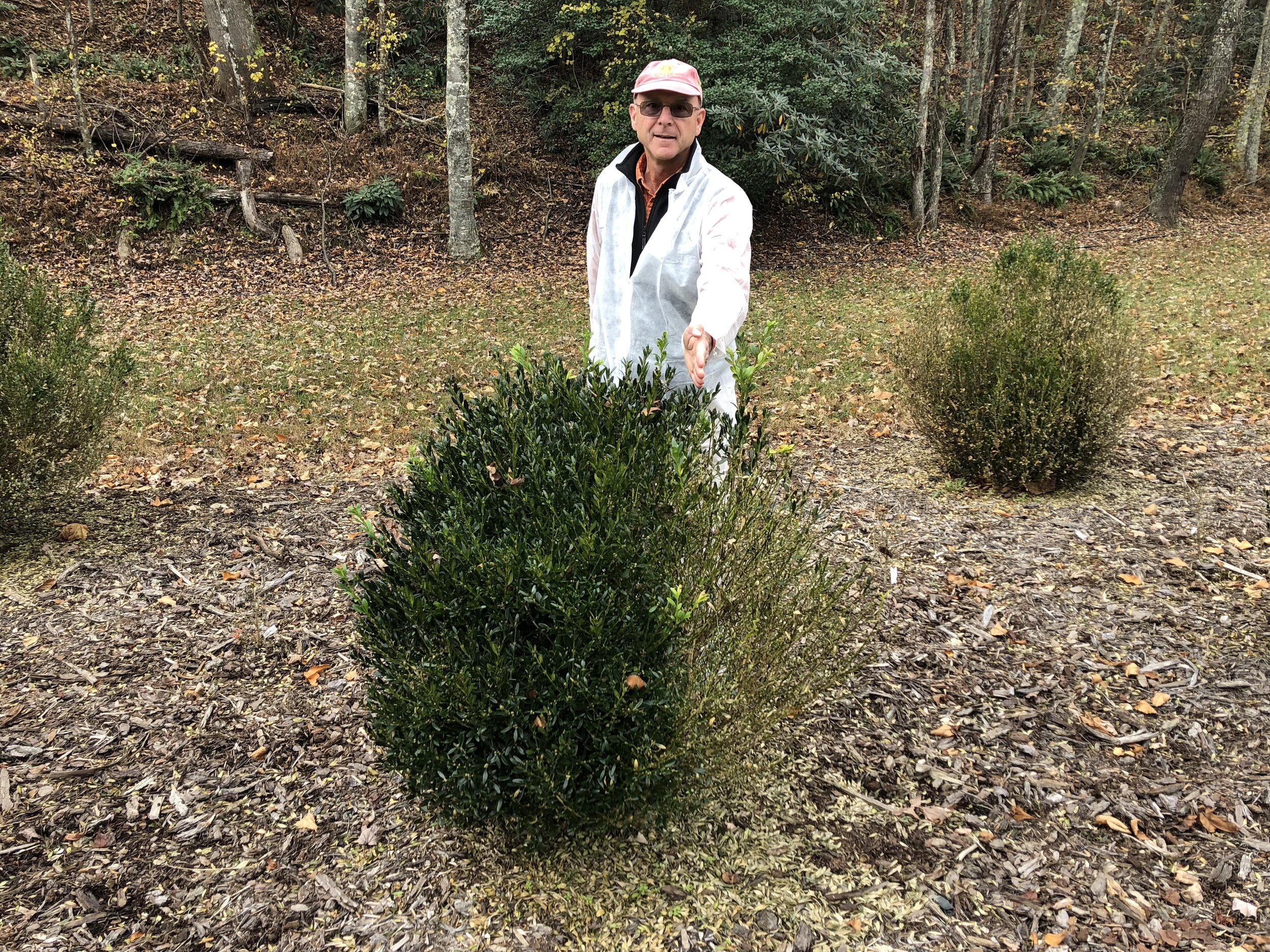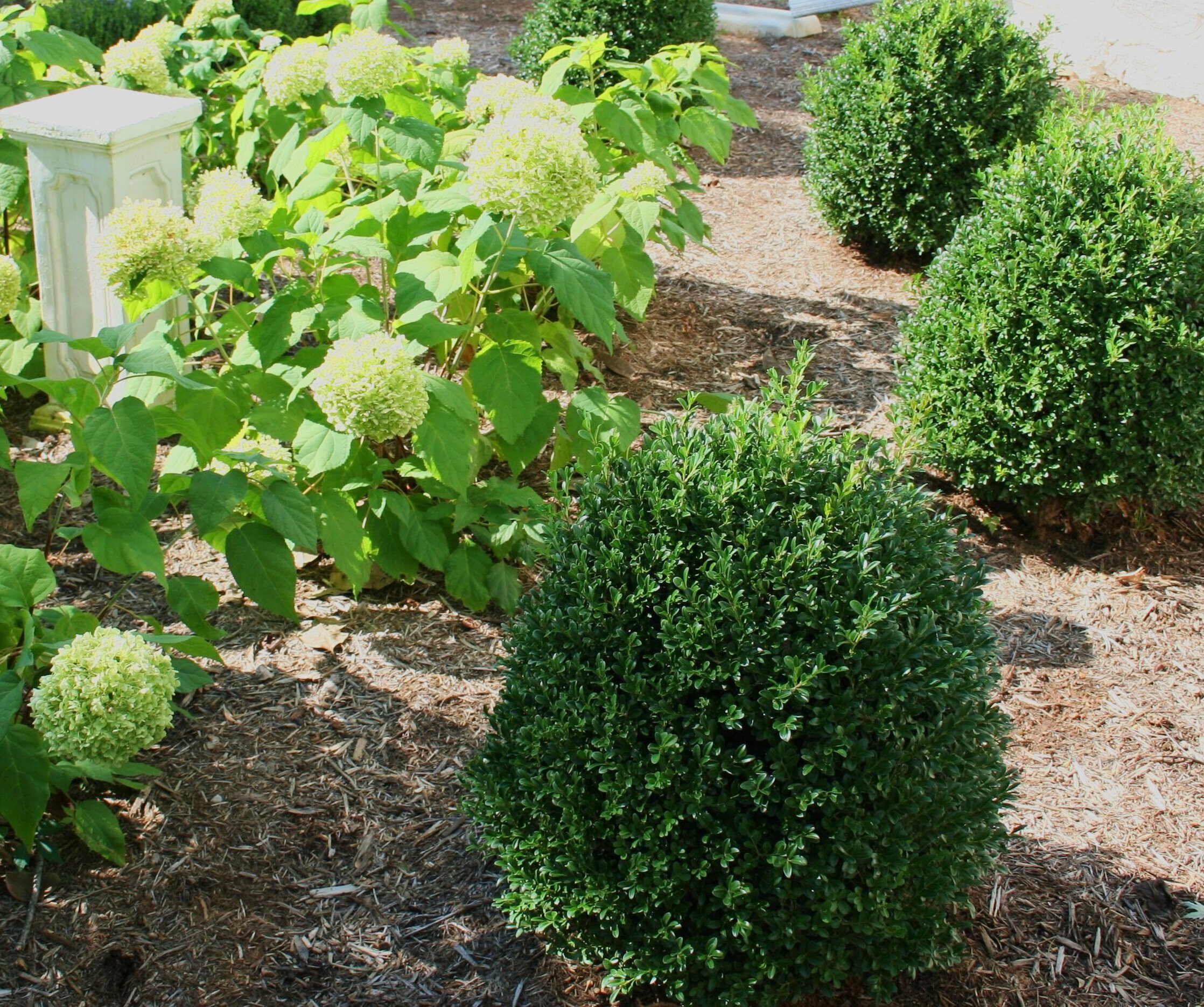Boxwood Blight
(Calonectria pseudonaviculata)
In 2011, it quickly became very clear that Boxwood Blight was a game-changer for the “aristocrat of ornamentals.” Unlike other ornamental plants, boxwood varieties and culture in the United States had changed very little since plants came from Europe in the 17th century. In the mid-Atlantic area, considered to be the heart of traditional boxwood cultivation in the United States, the primary cultivars were still Buxus sempervirens ‘Suffruticosa’ and Buxus sempervirens, commonly called English and American boxwood, respectively. Both cultivars showed susceptibility to Boxwood Blight, and boxwood culture was changed forever.
Following is an in-depth discussion of the disease, including prevention and control, cleanup, chemical applications, best management practices, and the future of boxwood.
Scroll down or click the images below for details.
Understanding Boxwood Blight
Found in Europe in 1990’s. First identified in U.S. in 2011.
Affects plants in the Buxaceae family: Buxus (boxwood), Sarcococca (sweet box), and Pachysandra (spurge).
Spores are heavy and sticky and are moved on plants by people, debris, equipment, and splashing water.
Fungus first appears as brown or black spots on foliage with yellow or brown rings.
Diseased leaves rapidly defoliate.
After defoliation, infected areas usually have black streaks in the stem.
Fungus is fast moving in wet and mild temperatures (60-77° F is ideal).
In prolonged dry, hot, or cold weather, the fungus goes dormant only to reappear in wet and mild temperatures.
Fungus can survive for years in infected debris either on the plant or in the soil.
Once in the landscape, the fungus can be suppressed over time with Best Management Practices.
Current chemical options will kill active spores and suppress the disease.
In future plantings, always plant more resistant cultivars.
Map of U.S. States with Known Cases of Boxwood Blight
Credit: Dr. Chuanxue Hong, Virginia Agricultural Research and Extension Center
Boxwood Blight is caused by the fungal pathogen Calonectria pseudonaviculata (syn. Cylindrocladium buxicola). This disease only affects plants in the Buxaceae family which includes Buxus (boxwood), Sarcococca (sweetbox) and Pachysandra (spurge). Boxwood Blight was found in Europe in the late 1990’s and officially documented in the United States in the fall of 2011. It is unknown how the pathogen was introduced to the U.S., but likely traveled on infected plant material.
Boxwood Blight first attacks the foliage of boxwood, appearing as black or dark brown spots on leaves, most often at the base of the plant. In a few days of ideal weather conditions, those spots will develop yellow to brown rings around them and cover the leaf. Infected leaves fall off the plant in one to two weeks. Stems near infected leaves will develop black streaked lesions or cankers.
The Boxwood Blight spore is characterized as heavy (non-buoyant) and sticky, meaning it does not move in the wind but moves physically through water or debris. It is typically introduced to a plant by contact with infected plants, debris, tools and equipment, clothing, animals, water splash, or other means of direct contact.
Optimal Conditions for Boxwood Blight
Boxwood Blight is most prominent in times when foliage is continually wet for extended periods from constant irrigation, prolonged rain/dew, high humidity, with temperatures 60° to 77° F. If the fungus is introduced in non-optimal conditions (extreme cold or heat, dry foliage), the disease struggles to become established. When optimal conditions exist and the fungus is present, the disease can and will spread quickly. When conducive conditions subside, the fungus will go dormant in the form of microsclerotia or black streaks in the limbs of affected plants or debris. Blight can reside in stems of the plant or in debris on the ground in an inactive state for long periods of time and reappear when conditions become optimal again.
Plant Disease Triangle
The plant disease triangle is a visual tool that represents the 3 essential components of a plant disease, in this case Boxwood Blight. All three of these must be present for Boxwood Blight to exist. If only one of the elements disappears, then the disease will cease to exist. For instance, if the environmental temperatures are around 50 degrees Fahrenheit and there is rain, a susceptible cultivar, and previously infected plants nearby, the disease will not develop because the temperatures are too cool.
On the other hand, if there are:
many infected plants nearby,
sufficient wetting, ideal temperatures, and a spreading mechanism, and
a susceptible cultivar,
Then the disease will appear, and the severity of the disease will be dependent upon how strong each of the elements are. If there are many infected plants, ideal weather for an extended period, and many plants of a susceptible cultivar, then you would expect a major problem with the disease.
The best way to avoid Boxwood Blight on new plantings of boxwood is to simply plant a cultivar which is more resistant to the disease.
Pathogen Present
The pathogen is characterized by heavy, sticky spores which normally do not travel by wind.
Vectors that spread the disease include water splashing, infected plants entering the landscape, or movement of plant debris by animals, clothing, tools, or equipment.
Spores can survive in the soil for long periods of time.
Susceptible Host
Buxus sp. - There are tremendous differences in the susceptibility of different boxwood cultivars to Boxwood Blight. Know the susceptibility of cultivars in your garden.
Sarcacoca sp. - Common Sweet box
Pachysandra sp. - Japanese Spruge
Ideal Environment
Ideal temperatures between 60-77° F
Little or poor air movement promotes the disease.
Events of prolonged wetness, either from rainfall or irrigation, encourages the disease.
In prolonged dry, hot, or cold weather, the fungus goes dormant only to reappear in wet, warm temperatures.
Identifying and Diagnosing
Boxwood Blight
Boxwood Blight’s most characteristic symptoms include circular brown/black leaf spots, dark black streaks or lesions on the stems of the infected plant, and rapid defoliation. Click through the photo gallery to see examples of these symptoms.
Leaf Spot:
Stem Lesions:
Defoliation:
Preventing Boxwood Blight
Foot baths are an effective way to sanitize employee and customer shoes as they enter and leave a boxwood landscape.
Educate yourself and others.
Use nurseries, landscapers, and lawn care companies who are aware of and educated about the disease and use practices to prevent introducing or spreading the disease.
Clean tools and equipment regularly, and launder clothes daily.
Lessen or eliminate sharing of tools across other landscapes.
Prune and plant boxwood to promote good airflow in and around the plant.
Avoid overhead irrigation. Dry foliage is important.
Choose cultivars carefully based on desired size and resistance to Boxwood Blight.
Mulch to lessen water splash.
Boxwood Blight is best avoided with good cultural and care practices. Educate yourself and other gardeners about the disease and know how to identify it. There is a great deal of information available on the internet and other publications on the disease including the Virginia Boxwood Blight Task Force, and the Horticultural Research Institute’s Best Management Practices. Understand how to minimize the disease’s movement within the landscape, as it can be present and not yet known. You should purchase healthy plants from reputable suppliers who are aware of the disease and are taking steps to avoid and control its movement. Many states now have Boxwood Blight compliance agreements that nurseries can or must participate in.
For landscapers, it is recommended that you have discussions with anyone who helps maintain a landscape including those who mow lawns. Make sure they are aware of the disease and are taking steps to lessen the movement of Boxwood Blight in the event they are exposed to it. Ask if they have been in other landscapes containing boxwood before coming to your landscape.
Crews at Saunders Brothers wear disposable clothing during normal workdays to prevent the spread of Boxwood Blight.
Anyone working in and around boxwood should wear freshly laundered clothes. Hot and soapy water from laundering will kill the spores. Properly clean tools and equipment with disinfecting agents like alcohol, bleach, and other products before and after use in boxwood.
Avoid overhead irrigation, when possible, to maintain dry foliage and limit water splashing. The disease does not spread when foliage is kept dry. Plant and prune boxwood to promote air flow in and around them. This will allow the boxwood to dry much faster after wet periods, thus reducing the likelihood of infection. Mulch annually (no more than 1”) to lessen water splash that will spread the disease. Recent research shows the value of properly mulched boxwood in the control and management of Boxwood Blight.
Properly select cultivars for each application based on ultimate desired size and shape to avoid over-pruning. Many problems, in addition to Boxwood Blight, can occur if a plant is too big for its specific application in the landscape and it must be pruned heavily to maintain the ideal size. If heavy shearing is necessary, take care to annually thin the plant to allow air penetration into it. Avoid sites with less air movement or where Boxwood Blight has been found.
Boxwood Blight Resistance
Buxus sempervirens cultivars are typically more susceptible.
Buxus microphylla, Buxus insularis, and Buxus harlandii cultivars and species are typically more resistant.
Open and upright plants, including some Buxus sempervirens tend to be less susceptible.
Shorter, more compact plants, including some of the Buxus microphylla tend to be more susceptible.
Boxwood Blight research is producing a large amount of valuable information. When tested in a lab in petri dishes, all boxwood are susceptible to Boxwood Blight. However, there are significant differences when tested in landscape or production scenarios. Buxus sempervirens ‘Suffruticosa’ (English boxwood) is the most susceptible cultivar. The Buxus microphylla, Buxus insularis, and Buxus harlandii species and cultivars tend to have more resistance to Boxwood Blight than the Buxus sempervirens cultivars. It is difficult to completely group based on species as there are exceptions based on plant architecture and structure. Open, more upright plants tend to be less susceptible while short, compact cultivars seem to be more susceptible.
Based on current Boxwood Blight research, the following list shows many common boxwood cultivars and their relative resistance of Boxwood Blight.
NewGen Independence® in a field trial shows natural resistance to Boxwood Blight compared to a less resistant, Buxus sempervirens cultivar.
A New Generation of Boxwood:
For over 70 years, Saunders Brothers, Inc. and Saunders Genetics have tested and trialed boxwood in search of varieties and cultivars that excel against pests and diseases, as well as thrive in the landscape. Working alongside many organizations and universities, they have evaluated 157 different cultivars of boxwood for their resistance to Boxwood Blight. Starting in 2012, Saunders Brothers, Inc. provided the boxwood for Kelly Ivors’ Boxwood Blight research through North Carolina State University. Her diligent work over 3 years culled out many blight-susceptible varieties. In 2015, Saunders Genetics privately began its own field testing of the most promising cultivars, confirming Ivors’ work while also finding other cultivars. Her most promising cultivars continued to be at the top of the list.
Since learning about the disease, enormous resources have been dedicated to learning about Boxwood Blight. Saunders Brothers, Inc. has donated thousands of plants, given input into multiple research projects, and made every attempt to better educate themselves and the growing community about this disease. Teams have traveled domestically and internationally to better understand a disease that many people thought would be the end of boxwood. Working with researchers from state and federal agencies, as well as international groups, the continued message was apparent that through a greater understanding of the disease, the battle with Boxwood Blight will be won with more resistant varieties and Best Management Practices.
In 2020, Saunders Genetics LLC introduced NewGen Independence® and NewGen Freedom®, two new cultivars which, through years of testing have shown to have better resistance to Boxwood Blight, better resistance to Boxwood Leafminer, and a WOW factor in the landscape. These have superior attributes to other boxwood on the market, and when combined with Best Management Practices, offer an outstanding future for boxwood.
By maintaining secure testing methods and standards, NewGen® intends to continue making introductions of superior plants that maintain brand standards. By establishing a regional network of premier licensed growers and propagators these plants will be available in retailers and landscapes all over the United States. With two initial introductions, NewGen™ raises the bar for boxwood, meeting the changing dynamics of a new generation of the American garden and gardener.
NEwGen Independence®
NewGen Freedom®
Click the buttons above for additional information on
Best Management Practices, Controlling Boxwood Blight and Boxwood Blight Cleanup































